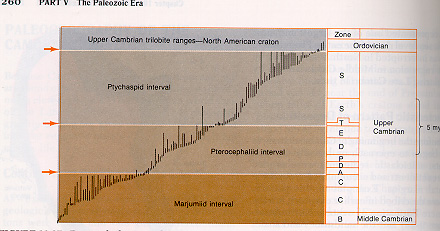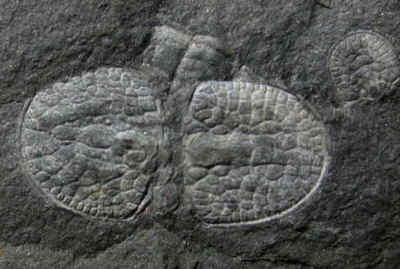
| Cambrian Period | ||
| Paleozoic Era | The Furongian Epoch |
| Middle Cambrian | Ediacaran | Cambrian | ||
| Early Ordovician | Ordovician | Paiban | Timescale |
Paleozoic |
Introduction Ecosystems Furongian Life Links |
The Late Cambrian has recently acquired an official name, the Furongian Epoch. It consists of the Paibian Age and an unnamed an Late Furongian ("Dolgellian") Age. Not coincidentally, the GSSP occurs near the Chinese village of Paibi, in the incredibly beautiful -- and almost vertical -- Wuling Mountains of northwestern Hunan Province. The Late Cambrian is marked by the first appearance of perhaps the very first agnostid trilobite, Glyptagnostus reticulatus, at Paibi. Agnostids are strange, rather primitive-looking trilobites. At first glance they look more like castanets than arthropods. The front and back sections of the shell (the cephalon and pygidium) are simple parabolic sheilds. The middle section (thorax) is segmented, but short. Like many other agnostids, Glyptagnostus is eyeless and quite small.

During this time their evolved deeper burrowers and grazing increases, creating increasingly Phanerozoic-style substrates (poorly laminated shallow water sediments and soupy water-sediment interfaces) which led to the extinction of taxa like helioplacoids that required hard sediment-water interface. Mat scratchers and mat miners migrated upwards towards littoral (tidal and intertidal) zone and downwards to deeper water.
What's happened here? One theory is that the substrate was beginning to change. The Early Cambrian sea floor seems to have been compact and stiff. A number of reasons are cited for this condition. Most importantly, metazoan worms were relatively rare. In all other parts of the Phanerozoic, the upper layers of shallow seas are full of marine worms, molluscs, and tiny arthropods, constantly churning and reworking the sea floor. In the Early and Middle Cambrian, these were much less common. Algal mats penetrated the intersitices between sediment particles, fixing and stiffening the sea bottom. Given time, these mats grew into dome-shaped stromatolites, which are frequently found covering near-shore sea bottoms throughout the Cambrian and well into the Ordovician.
By the Furongian, metazoans had been chewing holes in this mat, and in the sea floor, for about 40 My. Some parts were beginning to resemble the loose, muddy and unconsolidated sea floor of our own day. For reasons less easily explained, the rate of weathering on land also increased, so that the amount of recently deposited sediment was, on average, also somewhat larger that in previous epochs. The larger, superficially more advanced trilobites of the Middle Cambrian would have literally dug their own graves in this new, muddier world. By contrast, the tiny, clam-like agnostids were well equipped to dig into -- and out of -- the loosened substrate.
Image: Glyptagnostus reticulatus from Passagen
Trilobites, brachiopods, and other typical Cambrian groups continued to flourish. molluscs diversified with the appearance of many new clades. Graptolites appear (mostly benthic forms). Also during the Late Cambrian, conodonts first appear. These were probably fast swimming micropredators, soft-bodied chordates, possibly even vertebrates, with flattened elongate eel-like bodies. They are known almost entirely from their hard (calcium phosphate) tooth-like elements (common as microfossils), but a few instances of soft tissue preservation revealed their physical form. They survived until end of the Triassic. There is currently no evidence for land plants in the Cambrian.

As we might expect, the environmental changes in the Furongian led to a general turnover of organisms in the great shallow seas of the Cambrian. Many sources refer to these as "mass extinctions." However, we might reserve that term for a relatively small number of events of greater magnitude and severity. In a biotic turnover "event," most organisms are simply replaced by other organisms of a similar type. The mechanism of replacement is likely to involve a significant amount of natural selection by competition. A mass extinction ought to mean elimination of multiple species without competitive selection, such as by a natural disaster. These are two extremes of a continuum, but it is sometimes useful to distinguish between the two mechanisms.
It appears that trilobites, and probably other groups, turned over about three times during the Furongian, with the most profound change occurring at the very end of the Cambrian. The end-Cambrian event comes much closer to to being a mass extinction. Some workers believe that the Cambrian ended with a major cooling episode -- possibly even a minor ice age. We have to be somewhat careful with this sort of hypothesis. The number of biotic events which have been recently ascribed to climate changes exceeds even the number tied to extraterrestrial impacts. (We eagerly await the discovery of a mass extinction caused by a glacier from outer space.) These explanations are not necessarilly wrong, but they give off the general odor of a scientific fashion which may or may not survive more rigorous analysis.
Image: from Steven M. Stanley Exploring Earth and Life through Time
Annelida: No evidence of differentiation from stem group of Coeloscleritophora (Halkeria, Wiwaxia)?
Phyllodocida may have been present since Middle Cambrian, (implying considerable cryptic development). "(see Conway Morris and Peel 1995; Fauchald and Rouse 1997)." "Outgroup comparisons imply that the plesiomorphic mode of feeding in annelids, mollusks, and the Cambrian preannelidan halkieriids is unselective microphagous grazing, in which a radula or other toothed structure loosens and gathers particles from hard surfaces and sediments" numerous cites) Thesis is that herbivory did not constitute a major guild in the Paleozoic. Scolecodonts are not known until the Ordovician. Vermeij, GJ & DR Lindberg (2000), Delayed herbivory and the assembly of marine benthic ecosystems. Paleobiology 26: 419-430.
page uploaded 15 May 2002, last modified 27 October
last modified ATW040521
checked ATW060102